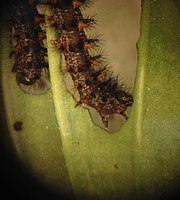| Euphydryas editha taylori | |
|---|---|

| |
| Conservation status | |
 Endangered (ESA) | |
| Scientific classification | |
| Domain: | Eukaryota |
| Kingdom: | Animalia |
| Phylum: | Arthropoda |
| Class: | Insecta |
| Order: | Lepidoptera |
| Family: | Nymphalidae |
| Genus: | Euphydryas |
| Species: | E. editha |
| Subspecies: | E. e. taylori |
| Trinomial name | |
| Euphydryas editha taylori (W.H. Edwards, 1888) | |
Euphydryas editha taylori, the Whulge checkerspot or Taylor's checkerspot, is a butterfly native to an area of the northwestern United States and Vancouver Island.
Description
Taylor's checkerspot is the darkest subspecies of the genus Euphydryas. It is a subspecies of Edith's checkerspot. This butterfly has a wingspan of less than 2.25 inches (57 mm). It gets its name from the checkered color pattern on its wings that consist of black, orange and white coloring. Taylor's checkerspot once ranged from the Willamette Valley in Oregon to Vancouver Island in British Columbia.
Chemical ecology
Taylor's checkerspot larvae rely on complex multitrophic interactions for survival. The larvae feed upon certain plant species in the native Castilleja and exotic Plantago genera that produce defensive compounds called iridoid glycosides. Over time, the Taylor's checkerspot has developed a tolerance for these compounds, such that the larvae are able to consume the foliage of these plants and sequester the compounds in their own tissues. These compounds then confer chemical protection against bird predators to the larvae.
Conservation status
The Taylor's checkerspot butterfly is at extreme risk of going extinct. It was listed as endangered under the U.S. Endangered Species Act in 2013. In 2006, it was listed as state-endangered in Washington, where an active conservation program is underway. In Oregon Taylor's checkerspot is on the Threatened and Endangered Species list, but receives no protection under state statute. Before its dramatic decline Taylor's checkerspot was documented at more than seventy sites, but is currently found only at ten sites in Washington and two in Oregon. It is currently listed as endangered in Canada, owing to the recent discovery of populations on Denman Island.
Threats
The biggest threat to its survival is the loss of prairie habitat due to contemporary settlement. More than 99% of the lowland prairies has been destroyed. The reason for this is that prairies are prime locations for agriculture as well as development of all types due to the lack of trees and flat topography. Along with habitat loss the subspecies is impacted by pesticide use that makes their plight even worse. Increased risk of harm due to drought is another major concern since they are now stuck on these patches of habitat with no chance to migrate to more suitable places.
Image gallery
-
 Early instar Euphydryas editha taylori larvae viewed under a dissection scope for observation
Early instar Euphydryas editha taylori larvae viewed under a dissection scope for observation
-
 Late instar Euphydryas editha taylori larva eating a Plantago lanceolata leaf, from which it sequesters defensive compounds known as iridoid glycosides.
Late instar Euphydryas editha taylori larva eating a Plantago lanceolata leaf, from which it sequesters defensive compounds known as iridoid glycosides.
-
 Lab-reared Euphydryas editha taylori feeding on honey water at the University of Washington Terrestrial Restoration Ecology lab
Lab-reared Euphydryas editha taylori feeding on honey water at the University of Washington Terrestrial Restoration Ecology lab
References
- ^ S. H. Black & D. M. Vaughan (May 2005). "Species profile: Euphydryas editha taylori" (PDF). In M. D. Shepherd, D. M. Vaughan & S. H. Black (ed.). Red List of Pollinator Insects of North America. CD-ROM Version 1. Portland, Oregon: Xerces Society.
- ^ Haan, Nate L.; Bakker, Jonathan D.; Bowers, M. Deane (14 January 2021). "Preference, performance, and chemical defense in an endangered butterfly using novel and ancestral host plants". Scientific Reports. 11 (992): 992. Bibcode:2021NatSR..11..992H. doi:10.1038/s41598-020-80413-y. PMC 7809109. PMID 33446768.
- ^ Haan, Nate L.; Bakker, Jonathan D.; Bowers, M. Deane (May 2018). "Hemiparasites can transmit indirect effects from their host plants to herbivores". Ecology. 99 (2): 399–410. Bibcode:2018Ecol...99..399H. doi:10.1002/ecy.2087. JSTOR 26624251. PMID 29131311. Retrieved 2022-05-02.
- "Federal Register :: Request Access".
- "Rare butterfly, thought to be extinct in Canada, making a comeback on Vancouver Island". Victoria Times Colonist. 30 March 2022. Retrieved 2022-05-02.
- "Information archivée dans le Web" (PDF).
- Paula Bock (July 15, 2007). "Butterflies aren't free. Saving the planet one bug at a time" (PDF). Seattle Times.
- Cheryl Fimbel (2004). Habitat enhancement for rare butterflies on Fort Lewis prairies (PDF) (Report). South Puget Sound Prairie Landscape Working Group. Archived from the original (PDF) on 2010-12-29. Retrieved 2011-03-19.
Further reading
- Glassberg, Jeffrey Butterflies through Binoculars: The West (2001)
- Guppy, Crispin S. and Shepard, Jon H. Butterflies of British Columbia (2001)
- James, David G. and Nunnallee, David Life Histories of Cascadia Butterflies (2011)
- Pelham, Jonathan Catalogue of the Butterflies of the United States and Canada (2008)
- Pyle, Robert Michael The Butterflies of Cascadia (2002)
External links
- Cascadia Prairie Oak Partnership technical library items on Taylor's checkerspot (Euphydryas editha taylori)
- Butterflies and Moths of North America
- Butterflies of America
| Taxon identifiers | |
|---|---|
| Euphydryas editha taylori | |
| Occidryas editha taylori | |